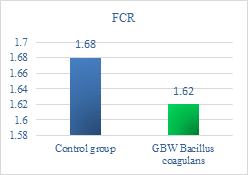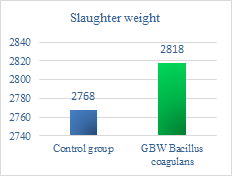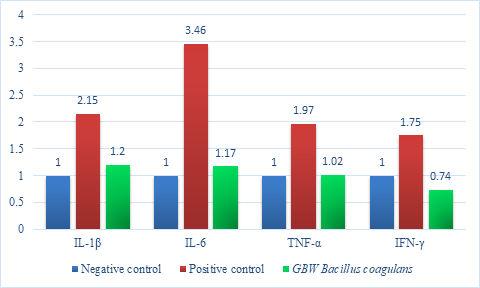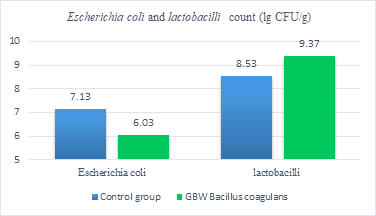Bacillus Coagulans

About Bacillus coagulans
Lactobacillus are the first and most common used probiotics. But there's two disadvantage for the use in livestock
production. First, strictly storage condition, most of the Lactobacillus need to store under refrigeration. Second, lower
recovering rate after pelleting, almost all strain of Lactobacillus are not tolerance high conditioning temperature.
Bacillus coagulans is a Gram-positive, facultative anaerobic, spore-forming, lactic acid producing bacillus. Bacillus
coagulans has been added by the EFSA to their Qualified Presumption of Safety list and has been approved for
veterinary purposes as GRAS by the FDA for Veterinary Medicine.
Why choose GBW Bacillus coagulans (CGMCC13044)?
GBW Bacillus coagulans contain spore of Bacillus coagulans CGMCC13044, this strain was well selected by GBW
Group, followed by massive laboratory and field testing, which has been patent deposited in China General
Microbiological Culture Collection Center.
lCompared with lactobacillus the spores of GBW Bacillus coagulans protect them against:
(1) high temperature and high pressure during pelleting.
(2) the attack of acid, digest enzyme, bile in the digestive tract.
lGBW Bacillus coagulans has been proved have excellent lactic acid producing and pathogen inhibition ability
compared with Lactobacillus, no matter in the in-vitro or in-vivo condition.
lThe extracellular polysaccharide structure of GBW Bacillus coagulans contain fucose monomer and β-1, 3, β-1, 6
glucan glycosidic bond, which has strong immune activate function.
lSecret protease, amylase that improve the digestibility of nutrients in the lower gastrointestinal tract.
lAerobic respiration of Bacillus coagulans can quickly consume oxygen in the intestine, creating an anaerobic
environment and promoting the multiplication of beneficial anaerobic bacteria.
After ingested, the spores will mainly germinate in the lower part of ileum, multiply, temporarily colonize and
execute positive effect mainly in the hindgut.
Effect of GBW Bacillus coagulans on weaned piglets performance
Weaning imposes tremendous stress on piglets and is accompanied by marked changes in gastrointestinal physiology,
microbiology and immunology. Owing to these changes, the period following weaning is characterized by a high
incidence of intestinal disturbances with diarrhea and depression of growth performance in piglets.
A filed experiment was conducted on a commercial hog farm in china. The aim of this experiment was to investigate
the effects of GBW Bacillus coagulans on growth and health performance of weaned piglets.

Results:

Effect of GBW Bacillus coagulans on growth performance of broiler
A filed experiment was conducted on a commercial broiler farm. The aim of this experiment was to investigate the
effects of GBW Bacillus coagulans (CGMCC13044) on growth performance of broiler.
Results:


Effect of GBW Bacillus coagulans on LPS induced intestinal inflammation of broiler
LPS is the main toxin factor of E. coli and salmonella, which cause livestock enteric disease. The results shows
that administrate Bacillus coagulans to LPS challenged broiler can down-regulate the mRNA expression of
Pro-inflammatory factor, mitigate intestinal inflammation.

Effect of GBW Bacillus coagulans on Jejunum morphology and cecal colonization of E.coli and
Lactobacillus in broiler chicken
B. coagulans spores beneficially modulate GI microbiota, by increasing lactic acid bacteria, decreasing E.coli in broiler, and
increase the villi height thus increase the absorption of nutrients.
Trail design:
One-day old AA broiler chicks were provided by a commercial hatchery. The birds were randomly assigned to the
two groups (90 birds per group with 4 replicates). Feed and water were given ad libitum.
Control group, no additive.
GBW Bacillus coagulans group, supplemented GBW Bacillus coagulans via drinking water, final concentration is 105 CFU/mL.
Experiment period:42days.
At day 42 randomly select 3 chicks from every replicates and cecal contents were cultured for E.coli and Lactobacillus,
the segments of jejunum were used to test the Villus height and crypt depth.
Results:


Lengthening of villi increase total luminal villus absorptive area and subsequently result in satisfactory digestive
enzyme action and higher transport of nutrients at the villus surface. Moreover, the higher villus height to crypt
depth ratio in the broilers supplement with GBW Bacillus coagulans resulted in a decreased turnover of the
intestinal mucosa. A slower turnover rate of the intestinal epithelium results in a lower maintenance requirement,
which can finally lead to a higher growth rate or growth efficiency of the animal.

